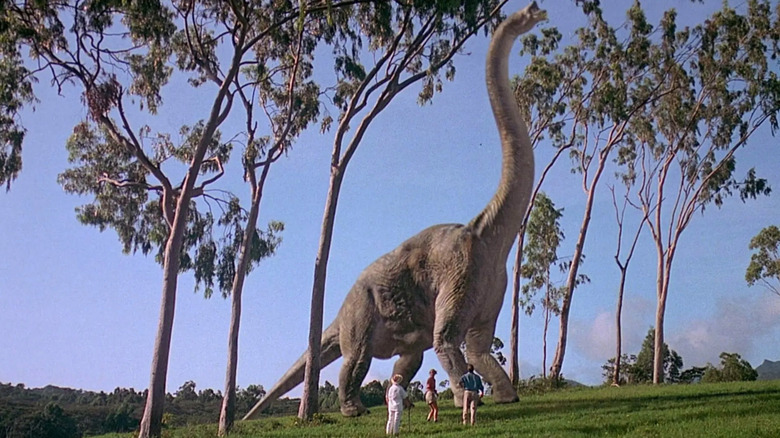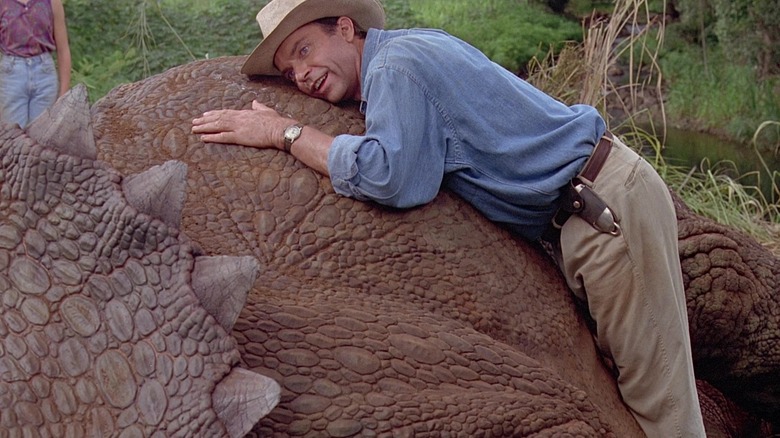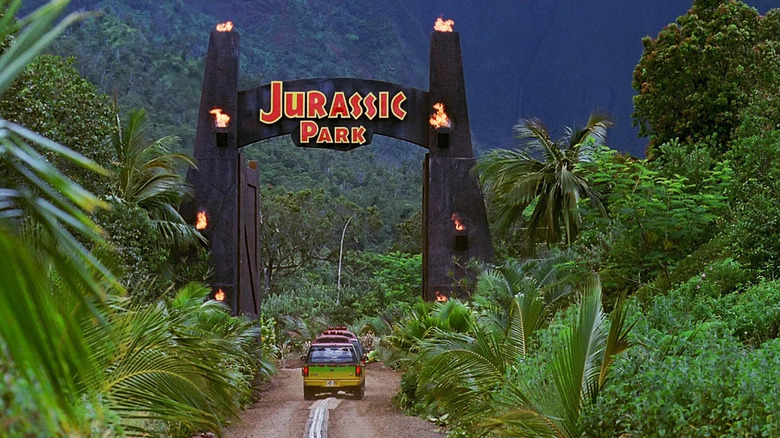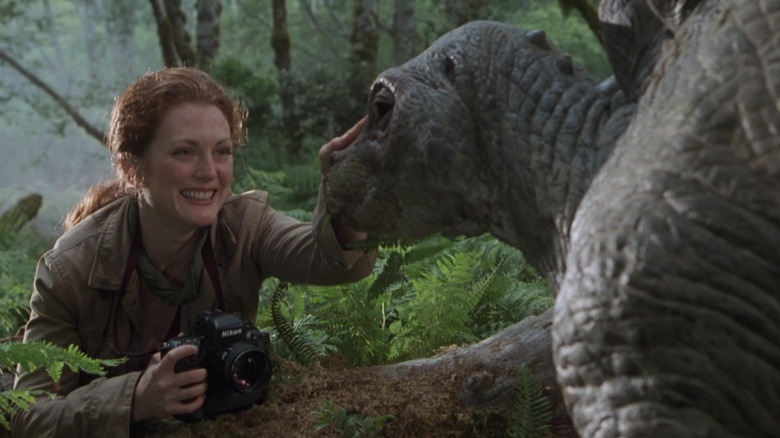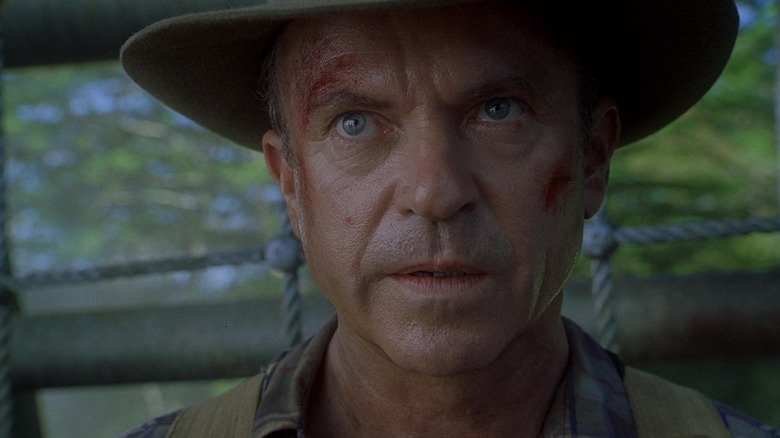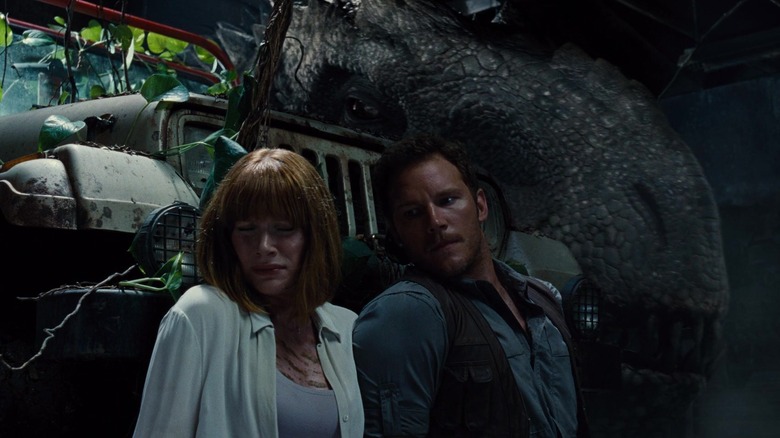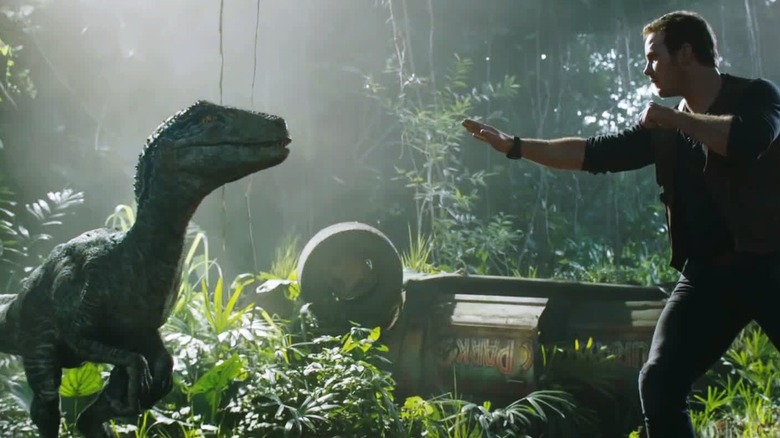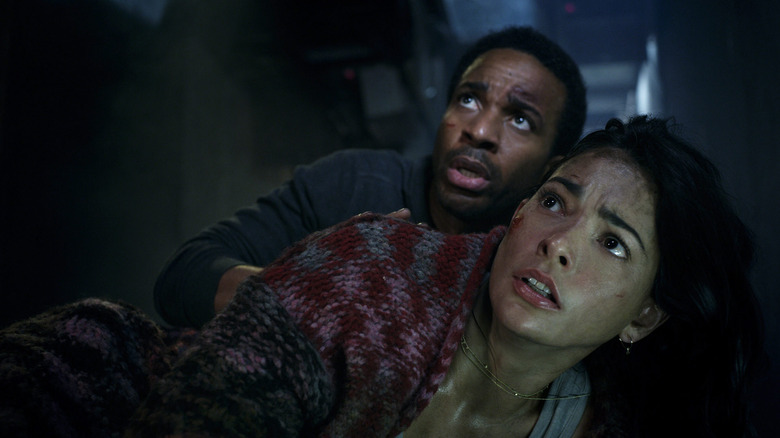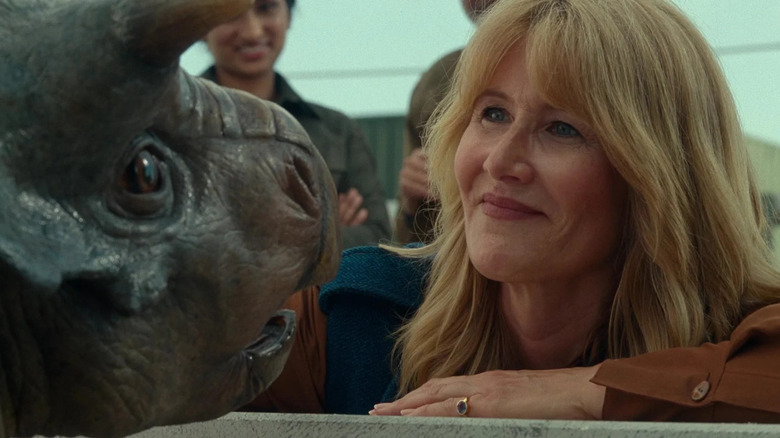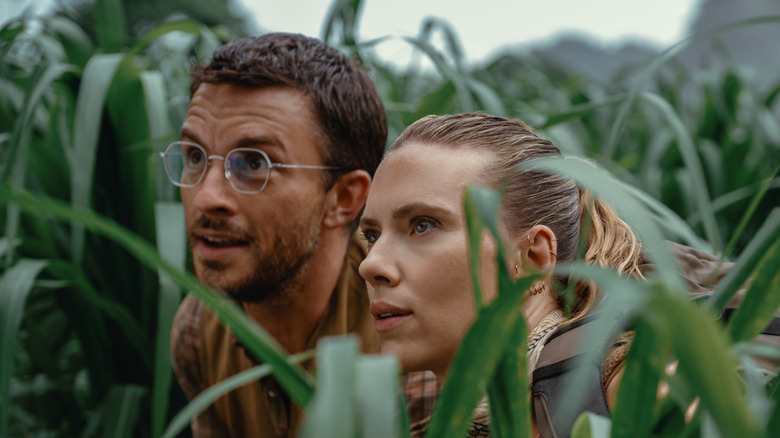How To Watch The Jurassic Park Movies In Order
Michael Crichton's novel "Jurassic Park" actually began its life as a 1983 screenplay about a graduate student that accidentally recreated a pterosaur in a lab. Crichton put it down, however, when he noticed the overwhelming volume of dinosaur media in the world. He picked it back up again when he realized that no one will ever get tired of dinosaurs and eventually turned his screenplay into his successful 1990 novel.
The rest is history. Steven Spielberg adapted "Jurassic Park" to film in 1993, and it became one of the highest-grossing movies of all time. In the ensuing 32 years, Spielberg's film gave rise to six "Jurassic Park" sequels, two animated TV shows, two live-action shorts, and a merchandise empire that is only outstripped by those of Marvel and the "Star Wars" franchise.
The canonical, live-action entries in the "Jurassic Park" property are as follows:
- "Jurassic Park" (1993)
- "The Lost World: Jurassic Park" (1997)
- "Jurassic Park III" (2001)
- "Jurassic World" (2015)
- "Jurassic World: Fallen Kingdom" (2018)
- "Battle at Big Rock" (2019)
- "Jurassic World Dominion Prologue" (2021)
- "Jurassic World Dominion" (2022)
- "Jurassic World Rebirth" (2025)
The films were released in chronological order, so their release date is the best way to watch them. There is a progression of history throughout the series, as the simple discovery and resurrection of dinosaurs leads very slowly to global dinosaur occupation. One can also witness the evolution of dinosaur cloning in the first "Jurassic Park" to out-and-out human cloning in "Jurassic World: Fallen Kingdom." Characters from the first "Jurassic Park" recur in later "Jurassic World" sequels, and it would be best to know who they are before watching late-stage "Jurassic" movies. It will also help if you come to see the Tyrannosaurus rex as a "good guy." Indeed, some of that dino's actions are depicted as deliberately heroic in the "Jurassic" films.
Why is this the correct order to watch the Jurassic Park movies?
"Jurassic Park" takes place in a sci-fi universe wherein paleontologists have found a way to extract dinosaur DNA from their blood, handily still inside the bellies of prehistoric mosquitoes trapped in amber. A wealthy tycoon named John Hammond (celebrated film director Richard Attenborough) then employs a private team of geneticists to clone dinosaurs from that DNA. His ultimate goal, however, has a lot less to do with scientific research and more to do with commercialism. He intends to build a dinosaur zoo, Jurassic Park, on a remote island off the coast of Costa Rica. The park is nearly complete when he invites Dr. Alan Grant (Sam Neill), Dr. Ellie Sattler (Laura Dern), Dr. Ian Malcolm (Jeff Goldblum), and a few others to witness a soft launch. As might be predicted, humanity proves to be its own worst enemy, and the terrible thunder-lizards are ultimately set loose to run amok. Naturally, this leaves the human beings to run for their lives.
The fictional science of "Jurassic Park" is repeated a lot throughout the sequels, with some films adding to it in new ways. The themes of hubris-soaked humans trying to gain mastery of the natural world also remains consistent, as do the anti-corporate ideas themes pertaining to financial interests outstripping human safety. As each movie builds on the last and relies heavily on audiences' extant affection for their characters, one must watch the "Jurassic Park" films in the order of their release. No skipping around, sadly.
Jurassic Park (1993)
Spielberg's "Jurassic Park" was made for a pretty pricey $63 million at the time, but went on to earn over a billion dollars at the box office. It also became the highest-grossing film ever at the time of its original release and held that record until "Titanic" arrived in 1997. Audiences, as Crichton noted, will never get tired of dinosaurs. There's a cute, understated moment in "Jurassic Park" that illustrates this: When Dr. Sattler exits a jeep to treat a sick Triceratops, Dr. Grant and Dr. Malcolm follow her. Alan sees the Triceratops laying on the ground and quietly conesses that, as a boy, the Triceratops was always his favorite. Dinosaurs fascinate little kids, and that fascination seems to be in full swing in "Jurassic Park."
It feels churlish to describe the plot of "Jurassic Park," seeing as it's one of the most popular films of all time. The movie's images, terminology, and individual scenes have all been quoted endlessly, satirized, ripped-off, and included in just about every single Oscars reel since 1993. Yes, audiences have now all noticed that Tim (Joseph Mazzello) could have been handing a gun to Ellie or Alan — who were busy trying to halt a Velociraptor break-in — than panicking and hitting the chair of his sister Lex (Ariana Richards). Yes, we're all aware that Dr. Grant had two "female" ends of his seatbelt early in the film and tied them together to make them work, which serve as a bit of subtle symbolism. (All dinosaurs on the island are female, but they still managed to find a way to reproduce.)
Because Spielberg made "Jurassic Park," however, it doesn't end on a cynical note. The bulk of the characters survive, and the dinosaurs are left to roam free. John Hammond isn't punished for his hubris, and Alan learns to be a father after having previously said he hates kids. It's warm and likable and proved to be just a little popular.
The Lost World: Jurassic Park (1997)
"The Lost World: Jurassic Park" felt like a weary obligation, and neither Crichton nor Spielberg initially wanted to make it. The plot involves Ian Malcolm trekking out to "Site B," the location where the dinosaurs were cloned in the first "Jurassic" movie. A storm ripped the facility apart and freed all the dinosaurs, who now roam freely. Ian's girlfriend, Dr. Sarah Harding (Julianne Moore), is already on the island taking pictures of dinos, under the pretense that Hammond needs evidence the dinosaurs should just be left alone. There is, however, a secret plot to spirit some dinosaurs away to San Diego and exploit them financially. "The Lost World" clearly owes a lot to "King Kong," and Crichton admitted he modeled his original novel after the John Wayne film "Hatari!" (a movie about big game hunters).
Although "The Lost World" was also an enormous hit (it made over $618 million at the box office), it wasn't nearly as beloved as its predecessor. It felt cornier and contrived and rushed. The third act sequence where a Tyrannosaurus charges through the streets of San Diego is more campy than terrifying, and no one likes the scene wherein Ian's daughter Kelly (Vanessa Lee Chester) uses her amateur gymnastics skills to kick a Velociraptor through a window.
The first "Jurassic" movie had small roles for recognizable actors like Wayne Knight, B.D. Wong, and Samuel L. Jackson. "Lost World" featured Vince Vaughn, Pete Postlethwaite, Arliss Howard, and Peter Stormare. It's certainly one of Spielberg's lesser films. He was likely distracted by his efforts to get his then-new studio, DreamWorks, off the ground.
Jurassic Park III (2001)
Spielberg, wholly done with the "Jurassic" franchise as a director, passed helming duties to Joe Johnston for "Jurassic Park III." Johnston proved that the "Jurassic" films are a B-movie property at heart. The sequel only runs 93 minutes and features scene after scene of dinosaur mayhem. The original "Jurassic Park" had a few questions as to the foolishness of messing with Mother Nature and how the "should" in science must always precede the "could." But while "The Lost World" tried to capture the same tone of caution (not to mention broader moments of Spielbergian wonderment), it fell flat and failed to back up its tone with actual profundity. "Jurassic Park III" is the movie "The Lost World" should have been, frankly, stripping away said profundity in favor of chills 'n' thrills.
Sam Neill returns as Alan Grant in "Jurassic Park III," which sees him accompanying a panicked couple (Tea Leoni and William H. Macy) to Site B to find their missing son Eric (Trevor Morgan). There's also a new "bad guy" dinosaur on the island in the form of a Spinosaurus, a spindly carnivore larger than a Tyrannosaurus. "Jurassic Park III" also features Pterosaurs that had previously been kept in an enormous aviary.
"Jurassic Park III" was made for a sizable $93 million (the most expensive "Jurassic" film up to that point) and "only" grossed about $366 million at the box office. It was hardly a bomb, but it seemed the bloom was off the rose for Spielberg's dinosaurs. It felt, at the time, like everything was pretty much over and the franchise had run its course. What we couldn't have predicted, however, is how reboot-happy Hollywood would become in the 2010s.
Jurassic World (2015)
Colin Trevorrow's "Jurassic World" was the first film in history to make over a half-billion dollars in a single weekend. It cost a Smaug's fortune to make, requiring $215 million (by some estimates), but it seems that it was worth it. Trevorrow hit a nostalgic sweet spot, and audiences showed up in droves ... which was weird, given how mediocre the film is. "Jurassic World" isn't as bad as "The Lost World," but it's not particularly astounding in any other capacity.
It seems that there was a contingent of "Jurassic Park" fans who always wanted to see the titular park in full swing, full of hundreds of dino-curious tourists, and well-stocked with Rainforest Cafés and Starbucks. "Jurassic World" delivered (well, in a PG-13 sort of way, and not a "Dinosaurs Attack!" kind of way), dramatizing a dinosaur outbreak in what was essentially the Universal Studios Hollywood theme park. The story around the mayhem-filled conceit is less interesting and involves a bland Velociraptor trainer named Owen (Chris Pratt) and the ultra-corporate manager of Jurassic World, Claire (Bryce Dallas Howard). Claire has two nephews named Zach and Gray (Nick Robinson and Ty Simpkins), and they, naturally, wind up finding themselves in extreme danger.
The film also features a fictional dinosaur in the form of the Indominus rex, a hybrid creature the Jurassic World scientists have engineered via genetic tinkering. By the time the third act rolls around, a Tyrannosaur ends up battling the Indominus, cementing the idea that the old-world monster is kind of the real hero of the "Jurassic" franchise.
Jurassic World: Fallen Kingdom (2018)
Because "Jurassic World" was so massively popular, the franchise was considered "rebooted" and efforts were immediately made to assure the "Jurassic World" brand would stay in the public consciousness in perpetuity. Hence, 2018 saw the arrival of J.A. Bayona's "Jurassic World: Fallen Kingdom," a film that reportedly cost a mind-scrambling $432 million to produce. (Even adjusting for inflation, that would make it the second most expensive movie of all time). It seems that it was worth it, though, as the film raked back $1.31 billion at the box office.
"Fallen Kingdom" continued the adventures of Claire and Owen by revealing that Isla Nublar, the island where Jurassic World had been built, is home to a now-active volcano that will soon erupt and kill most of the dinosaurs. Some mercenaries, however, rescue a few of the animals and take them to a remote haunted mansion (well, in vibes; it's not actually haunted) where bad guys have been genetically altering dinosaurs in secret. The film climaxes with an underground dinosaur auction, as James Bond-style evil billionaires try to outbid each other on, like, weaponized ankylosaurs. One of the human characters is even revealed to have been a clone this whole time, and the film ends with dinosaurs breaking out and infiltrating the world. It's a fun apocalyptic conclusion to an aggressively silly movie. The promise of a modern world overrun by dinosaurs is certainly tantalizing. It's too bad "Fallen Kingdom," as a whole, was so schlocky.
But it was a hit, so what do I know?
Battle at Big Rock (2019) and Jurassic World Dominion Prologue (2021)
"Fallen Kingdom" was such an overwhelming success that Colin Trevorrow soon after returned as a director to the "Jurassic World" franchise for "Battle at Big Rock," an eight-minute short that debuted on FX on September 15, 2019. It takes place a year after the great dinosaur escape at the end of "Fallen Kingdom" and centers on an American family who, while on a camping trip in Northern California, has a (very) close encounter with some dinosaurs in the wild.
Because "Battle at Big Rock" is only eight minutes, it doesn't have much of a story and is essentially just a survival picture. It's all about the aforementioned family (with André Holland and Natalie Martinez playing the parents) surviving an attack from an Allosaurus and a few Nasutoceratops. The film ends with a news footage montage of dinosaurs in the wild, inconveniencing humans. Dinosaurs are among us.
"Battle at Big Rock" was followed in 2021 by the release of Trevorrow's five-minute film "Jurassic World Dominion Prologue," an IMAX-exclusive title. It initially played on super-large screens on June 25 that year but was released online the following November. It's mostly a special effects reel, depicting multiple dinosaurs in their native timeline 65 million years ago. They gambol and attack each other. Flash forward to the present and a Tyrannosaur is racing around the modern world, stomping its way through a drive-in movie theater.
The events of Trevorrow's "Jurassic" shorts were meant to, as mentioned, tantalize audiences into anticipating "Jurassic World Dominion," which was presented as being a full-scale dinosaur apocalypse movie. Sadly, we didn't get that.
Jurassic World Dominion (2022)
Trevorrow's "Jurassic World Dominion" reportedly "only" cost $265 million to make but still raked in over a billion dollars worldwide. The movie sought to unite the heroes of the "Jurassic World" films — as again played by Bryce Dallas Howard and Chris Pratt — with the heroes of the "Jurassic Park" films, as portrayed by Sam Neill, Laura Dern, and Jeff Goldblum once more. Eventually, all five characters team up inside a special dinosaur enclosure and have to use their combined wits to survive. It's an underwhelming union, as there was nothing to be gained from having those particular characters interact. They were all mere zoologists, a few of many, who had dealt with dinosaurs.
Many were disappointed that "Dominion," despite all the promises, wasn't an apocalypse film. Dinosaurs were indeed out in the world, but they only occasionally interfered with human affairs. At most, dinosaurs were depicted as a strange new inconvenience. The plot then settled around a killer breed of outsized locusts that have the capability to consume the Earth's entire food supply. Dr. Sattler and Dr. Grant have to break into a secret facility to gain the means to take down the locusts. Also, the twisted scientist eager to keep dino experiments going is finally ousted. "Dominion" is underwhelming by all measures, settling on slick action and un-fun monster mayhem. This is a long, long way from the wonderment of Spielberg.
Jurassic World Rebirth (2025)
Due in theaters on July 2, 2025, "Jurassic World Rebirth" will take place five years after "Dominion," finally quashing the idea that audiences will be treated to a dinosaur apocalypse movie. It seems much of the Earth has proven inhospitable to the dinosaurs, which have since retired to the exact types of jungles where we first encountered them in "Jurassic Park." Indeed, the film primarily unfolds on a never-before-seen island that housed the since-abandoned research facility for the original Jurassic Park and follows a team of individuals (as played by Scarlett Johansson, Jonathan Bailey, and Mahershala Ali) as they set out to infiltrate the dinos' domain. Dinosaur DNA, it turns out, holds the key to a ground-breaking medical treatment for humanity, which means the film's leads have to sneak around the island and extract the DNA with their bare hands.
The "Jurassic" films, like the "Friday the 13th" movies before them, started with a spare and efficient idea but had to become weirder and more elaborate in order to strip-mine that concept for new material. The original film was a slicker version of a B-movie, featuring human characters fleeing dinosaurs in a dinosaur zoo. There's not much in the way of mythology that still had to be explored — everything was already explained pretty succinctly — so the sequels could only offer the same type of dinosaur mayhem, just with new characters or in different locations. The only way to expand the premise was to expand the series to a global scale, but the filmmakers didn't have the chutzpah to push "Jurassic World" into a full-blown apocalypse.
Too bad. Perhaps "Rebirth" will offer some interesting new ideas.
